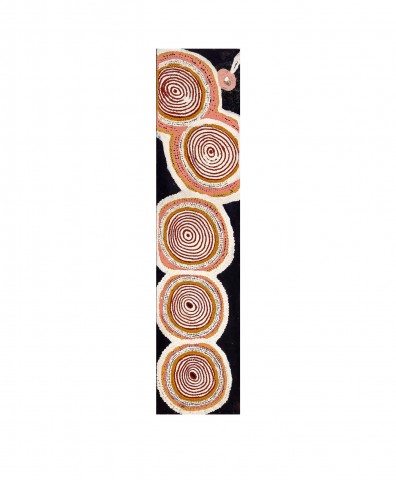TINGARI AT NYIRRIPI, 1990
CHARLIE WARTUMA (TARAWA) TJUNGURRAYI
synthetic polymer paint on board
153.0 x 34.5 cm
Papunya Tula Artists, Alice Springs, Northern Territory
Private collection, Melbourne
Aboriginal Art & Spirituality, The High Court of Australia, Canberra, 27 February – 14 March 1991; The Exhibition Gallery, The Waverley Centre, Wheelers Hill, Melbourne, 24 March – 5 May 1991; The Ballarat Fine Art Gallery, Ballarat, Victoria, 24 May – July 1991 (stamped verso)
Crumlin, R. and Knight, A., Aboriginal Art and Spirituality, Dove Publications, Victoria, 1991, pl. 49, pp. 83 (illus.), 140
This work is accompanied by a certificate of authenticity from Papunya Tula Artists, Alice Springs which states: ‘In a fascinating traditional design of concentric circles almost haptic in concept, the artist has depicted the Tingari Cycle associated with the travels of the Tingari ancestors west of Nyirripi. The roundels represent water soakages where the Tingari stopped to rest and drink during their long journey.’
Charlie Wartuma (or Tarawa or Tararu) Tjungurrayi was one of the leading lights in the genesis of the modern Western Desert painting movement that originated at Papunya in the early 1970s. Although painted in 1990, the format of Tingari at Nyirripi and the composition board support, hark back to the so-called ‘panel paintings’ made in the early 1970s on oblong sheets of board, usually off-cuts from the very building materials from which Papunya was constructed. The work relates to such paintings of similar proportions as Medicine Man or Man Dreaming, 1971, in the collection of the Museum and Art Gallery of the Northern Territory, Darwin, which also refers to the travels of the apical Tingari ancestors in the vicinity of Nyirripi.1 In the latter work, the sequence of the stack of roundels forms a type of headdress for a figure depicted naturalistically. By way of contrast, Tingari at Nyirripi retains a sense of ancestral geometry devoid of any naturalistic imagery.
1. Illustrated in Scholes, L. (ed.), Tjungunutja: From having come together, Museum and Art Gallery of the Northern Territory, Darwin, 2017, p. 30; and in Croker, A., Charlie Tjararu Tjungurrayi: A Retrospective 1970–1986, Orange Regional Gallery, Orange, New South Wales, 1987, p. 53
